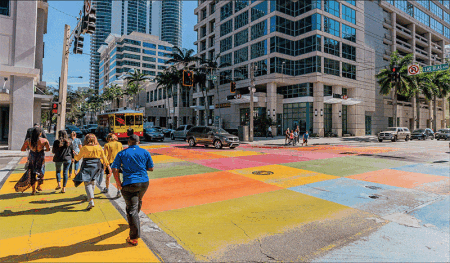
To help with congestion, Fort Lauderdale is planning to create a “circulator,” with two of the area’s main thoroughfares—Andrews Avenue and Third Street—updated to run one way. The improvements will include three lanes for cars, one lane for multipassenger vehicles, and widened sidewalks and bike lanes to make the city streets more accessible to residents.
Fort Lauderdale is the largest city in Broward County, the second-largest county in the state of Florida, and population growth shows no signs of slowing down. With recent metrics suggesting that Fort Lauderdale’s population grew as much as 9 percent last year, this rapid growth directly affects the area’s sluggish ability to adapt. Traffic remains a burden despite costly infrastructure investments like express lanes; housing affordability remains a major challenge; and a 300 percent increase in flooding in Fort Lauderdale has raised plenty of concern among city and county leaders.
“We want to maintain a quality of life that will keep bringing people back here, because that’s ultimately what governments do,” said Dean Trantalis, mayor of Fort Lauderdale. Joined by Broward County Mayor Mark Bogen and moderated by Jenni Morejon, the president and CEO of the Fort Lauderdale Downtown Development Authority, the panel reflected on some of the short-term policies being implemented to make major strides for local residents, tourists, and companies alike.
“We’re kicking off by tackling our biggest problem, which is congestion,” says Mayor Bogen. To alleviate chronic issues, Broward County recently implemented a transportation penny tax to fund a 30-year, $15 billion infrastructure investment. This surtax will fund hundreds of road traffic and safety improvements, reconfigure entire intersections, and ensure that some 700 city-requested updates are finally met.
“We’ve targeted the most important arteries in the city for light synchronization,” said Trantalis. Downtown Fort Lauderdale, for example, is poised to receive major improvements. The neighborhood has seen a 30 percent population growth in the last year while the area’s public transportation options have dwindled: downtown Fort Lauderdale’s trolley car—which zipped visitors to downtown Fort Lauderdale along seven different routes—was recently discontinued because the city “could no longer afford it,” according to Trantalis.
“The city would have been inundated with debt if we had continued to operate the trolley car,” said Trantalis. Instead, Fort Lauderdale is planning to create a one-way “circulator,” with two of the area’s main thoroughfares—Andrews Avenue and Third Street—updated to run one way. The improvements will include three lanes for cars, one lane for multipassenger vehicles, and widened sidewalks and bike lanes to make the city streets more accessible to residents.
A lack of affordable housing plagues the South Florida landscape generally, but each mayor remains relatively optimistic that new, voter-approved measures may alleviate some of the burdens facing residents. Though the city recently adopted a proviso that mandates that 15 percent of new housing units be workforce or affordable units, Trantalis warns that actually ensuring that the quota is met has been a challenge in the past. Bogen, meanwhile, stresses that Broward County cannot continue to rely solely on the tourism, real estate, and yachting industries if the city is to continue to attract global investment. “We need young people with specialized degrees looking at Fort Lauderdale as a place where they might want to start their families,” he says, noting that local investment into tech incubators might be one piece of the solution.
“Nova has opened a technology department to collaborate with industries and foster promotion of tech in Broward, and this momentum will certainly create a buzz to let people know it’s somewhere they may want to relocate,” added Trantalis.
In addition, both mayors noted that federal tax credit programs that allow the creation of an enterprise zone might be able to alleviate some of the burden for local governments by encouraging private investment to navigate the affordable housing crisis. Bogen, meanwhile, stressed that the county is focused on attracting new corporations to the region via incentives. “If you want to do business in Broward, we’re providing a lot of incentives to help you grow. We’re especially focused on attracting business from Central and South America,” he said.
The panelists also highlighted a group that is especially at risk to the housing crisis: Fort Lauderdale’s homeless population is one of the highest in the United States, with some 2,0000 individuals and 160 families sleeping in makeshift mattresses on the city streets. The city recently managed to eradicate a tenement camp in the heart of its downtown, placing nearly all of its homeless residents in temporary housing while implementing rehabilitation programs, mental health and addiction services, and workforce training programs to facilitate their ultimate independence from the system. To do so, the city counted with over $1 million in private investment, and even incorporated the court system in an effort to more strategically mitigate the issue.
Finally, both mayors shared their excitement over the upcoming redesign of City Hall, which will aim to merge both the county’s and city’s government operations onto a single campus. “We’re working together to combine resources and create a single government campus in downtown Fort Lauderdale and take advantage of 16 acres [6.4 ha] of available land,” said Trantalis. “We’d like to repurpose the campus as a gateway to the city, with a bus station and perhaps even a new business center, to make downtown Fort Lauderdale a vibrant downtown like it was many years ago.” With plans to file a letter of intent in March, Trantalis noted that the government will either self-fund the project or do so via a public/private partnership.
